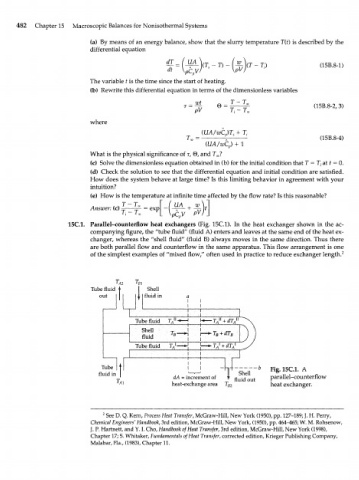Page 502 - Bird R.B. Transport phenomena
P. 502
482 Chapter 15 Macroscopic Balances for Nonisothermal Systems
(a) By means of an energy balance, show that the slurry temperature T(t) is described by the
differential equation
dT _ UA
(15B.8-1)
The variable t is the time since the start of heating.
(b) Rewrite this differential equation in terms of the dimensionless variables
(15B.8-2,3)
T - T
1 I - 1 ОС
where
(UA/wC )T
T = p 5 (15B.8-4)
(UA/wC )
p
What is the physical significance of r, 0, and T ?
x
(c) Solve the dimensionless equation obtained in (b) for the initial condition that Г = Г,- at f = 0.
(d) Check the solution to see that the differential equation and initial condition are satisfied.
How does the system behave at large time? Is this limiting behavior in agreement with your
intuition?
(e) How is the temperature at infinite time affected by the flow rate? Is this reasonable?
Г - Г Г
Answer: (с) _ те = exp
15С.1. Parallel-counterflow heat exchangers (Fig. 15C.1). In the heat exchanger shown in the ac-
companying figure, the "tube fluid" (fluid A) enters and leaves at the same end of the heat ex-
changer, whereas the "shell fluid" (fluid B) always moves in the same direction. Thus there
are both parallel flow and counterflow in the same apparatus. This flow arrangement is one
of the simplest examples of "mixed flow," often used in practice to reduce exchanger length. 2
Tube fluid t 1 Shell
out fluid in
Tube fluid
Shell
fluid
Tube fluid
Tube Fig.lSC.l, A
fluid in Shell
dA = increment of fluid out parallel-counterflow
heat-exchange area l B2 heat exchanger.
2 See D. Q. Kern, Process Heat Transfer, McGraw-Hill, New York (1950), pp. 127-189; J. H. Perry,
Chemical Engineers' Handbook, 3rd edition, McGraw-Hill, New York, (1950), pp. 464-465; W. M. Rohsenow,
J. P. Hartnett, and Y. I. Cho, Handbook of Heat Transfer, 3rd edition, McGraw-Hill, New York (1998),
Chapter 17; S. Whitaker, Fundamentals of Heat Transfer, corrected edition, Krieger Publishing Company,
Malabar, Fla., (1983), Chapter 11.

